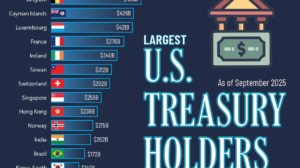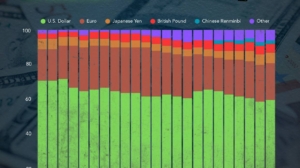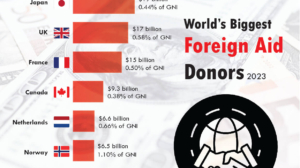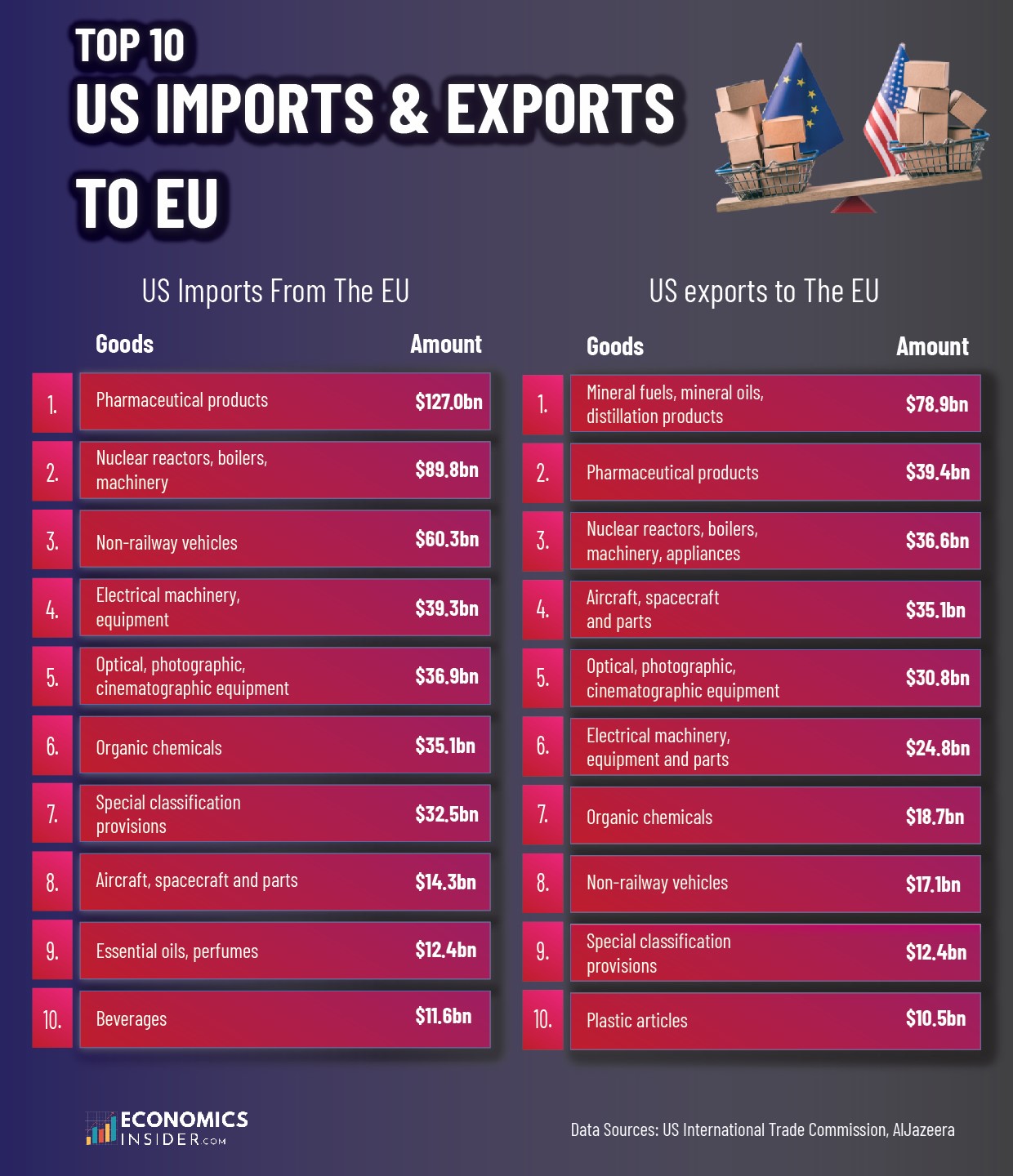The trade between the United States and the European Union involves hundreds of billions of dollars every year. In 2024, the U.S. imported around $605.8 billion worth of goods from the EU, while it exported approximately $370.2 billion to the region. This results in a trade deficit of approximately $235 billion for the U.S.—meaning the country buys much more from the EU than it sells. Among the most important goods traded between the U.S. and the EU are pharmaceuticals, machinery, vehicles, mineral fuels, and aircraft parts. The EU sends large amounts of medicines, cars, and mechanical equipment to the U.S., while the U.S. mainly exports fuel, planes, and medical products to Europe.
The trade imbalance between US and EU has long been a point of tension. President Donald Trump announced a 20% tariff on most EU goods. The rate was later reduced to 10% to allow for negotiation. However, once again Trump signaled his growing impatience, threatening to raise tariffs to 50% as soon as June 1 if talks fail to deliver results.
Key Takeaways
- In 2024, the U.S. imported $605.8 billion in goods from the EU and exported $370.2 billion.
- Major U.S. imports from the EU include pharmaceuticals, machinery, and vehicles, while key exports to the EU are mineral fuels, pharmaceuticals, and aircraft.
- The trade relations between the U.S. and EU are threatened by the US steep tariffs on EU goods, starting at 10% but possibly rising to 50% if current trade negotiations do not progress.
Major US Imports and Exports to the EU
The following tables show the top goods traded between the U.S. and the EU in 2024, covering both imports and exports.
Top 10 US Imports From the EU
| Goods | Amount (USD) |
|---|---|
| Pharmaceutical products | $127.0bn |
| Nuclear reactors, boilers, machinery, appliances | $89.8bn |
| Non-railway vehicles | $60.3bn |
| Electrical machinery, equipment and parts | $39.3bn |
| Optical, photographic, cinematographic equipment | $36.9bn |
| Organic chemicals | $35.1bn |
| Special classification provisions | $32.5bn |
| Aircraft, spacecraft and parts | $14.3bn |
| Essential oils, perfumes | $12.4bn |
| Beverages | $11.6bn |
Top 10 US Exports to the EU
| Goods | Amount (USD) |
|---|---|
| Mineral fuels, mineral oils, distillation products | $78.9bn |
| Pharmaceutical products | $39.4bn |
| Nuclear reactors, boilers, machinery, appliances | $36.6bn |
| Aircraft, spacecraft and parts | $35.1bn |
| Optical, photographic, cinematographic equipment | $30.8bn |
| Electrical machinery, equipment and parts | $24.8bn |
| Organic chemicals | $18.7bn |
| Non-railway vehicles | $17.1bn |
| Special classification provisions | $12.4bn |
| Plastic articles | $10.5bn |
The data is sourced from AlJazerra, US International Trade Commission.
The U.S. and the European Union have a strong and complex trade relationship. The EU is one of the largest trading partners for the United States. Every year, the two sides exchange goods worth hundreds of billions of dollars. However, the numbers show that the U.S. buys far more from the EU than it sells. This creates a significant trade deficit, which has become a political issue in recent years.
U.S. Exports to the EU
The U.S. exported approximately $370 billion worth of goods to the EU in 2024. The top item on the list was mineral fuels, oils, and related products. This makes sense, as the U.S. has ramped up energy production in recent years, especially natural gas and oil.
Another major export was pharmaceutical products, which reached approximately $39 billion. The U.S. is home to some of the world’s largest drug companies, and its medicines are in high demand across Europe.
Aircraft and spacecraft parts also made up a big share, bringing in $35.1 billion. Companies like Boeing contribute heavily to this sector.
Other notable exports include machinery, optical and photographic equipment, vehicles, and chemicals. These goods reflect the industrial and technological strengths of the U.S. economy.
Despite these strong exports, the U.S. still faces a trade gap with the EU, mainly because European exports to the U.S. are even higher.
EU Countries GDP Ranked: Which Nations Have the Largest Economies in 2025?
U.S. Imports from the EU
In 2024, the U.S. imported an approximately $605 billion in goods from the European Union. At the top of the list were pharmaceutical products, which totaled $127 billion. This shows how much the U.S. depends on European-made drugs, including vaccines, specialty medicines, and other treatments.
Next came industrial machinery and mechanical appliances, valued at $89.8 billion. These include engines, turbines, and various machine tools that are vital for U.S. manufacturing and production.
Vehicles, especially non-railway cars, added another $60.3 billion to the import total. Many popular car brands like BMW, Volkswagen, and Mercedes-Benz are made in Europe and shipped to American consumers.
Other important imports were electronics, optical equipment, organic chemicals, aircraft parts, and specialty items like perfumes and beverages. These items reflect Europe’s strong manufacturing and design capabilities.
While American consumers and businesses benefit from access to high-quality European goods, this large volume of imports is what drives the US trade imbalance with EU.
Rising Trade Tensions Between the US and EU
The recent announcement from President Trump about new tariffs on EU goods adds a new layer of uncertainty to the U.S.–EU trade relationship. Tariffs are essentially taxes placed on imports, and they make foreign goods more expensive. Initially set at 20%, the tariffs were scaled back to 10% to allow for negotiations. But now, Trump has warned that tariffs could jump to 50% if talks do not move forward.
The Trump administration used similar tariffs in trade disputes with China and other countries. Higher tariffs could make goods more expensive for U.S. consumers and businesses, and they might lead to retaliation from the EU. If the European Union decides to impose its own tariffs on U.S. goods, it could hurt American exporters, especially in agriculture and manufacturing.
Conclusion
The trade data shows how deep and important the U.S.–EU economic relationship is. The U.S. imported over $600 billion in goods from the EU and exported over $370 billion, revealing a significant trade deficit that has become a political flashpoint. Pharmaceuticals, machinery, and vehicles dominate the top traded goods between the two economies.
As trade between US and EU continues to grow, the future looks uncertain. The recent U.S. tariff threats raise questions about whether tensions will cool or escalate. If negotiations fail, and tariffs go up to 50%, both economies could suffer disruptions.





































Add Comment